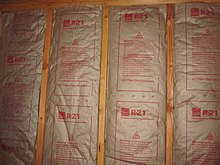
Back قيمة مقاومة حرارية Arabic Wärmedurchgangskoeffizient German Valor R (aislamiento) Spanish ആർ-വാല്യു (ഇൻസുലേഷൻ) Malayalam Valor R Portuguese Сопротивление теплопередаче ограждающих конструкций Russian Giá trị R (cách nhiệt) Vietnamese
This article needs additional citations for verification. (January 2024) |

The R-value (in K⋅m2/W) is a measure of how well a two-dimensional barrier, such as a layer of insulation, a window or a complete wall or ceiling, resists the conductive[2] flow of heat, in the context of construction.[3]. R-value is the temperature difference per unit of heat flux needed to sustain one unit of heat flux between the warmer surface and colder surface of a barrier under steady-state conditions. The measure is therefore equally relevant for lowering energy bills for heating in the winter, for cooling in the summer, and for general comfort.
The R-value is the building industry term[3] for thermal resistance "per unit area."[4] It is sometimes denoted RSI-value if the SI units are used.[5] An R-value can be given for a material (e.g. for polyethylene foam), or for an assembly of materials (e.g. a wall or a window). In the case of materials, it is often expressed in terms of R-value per metre. R-values are additive for layers of materials, and the higher the R-value the better the performance.
The U-factor or U-value (in W/m2⋅K) is the overall heat transfer coefficient and can be found by taking the inverse of the R-value. It is a property that describes how well building elements conduct heat per unit area across a temperature gradient. [6] The elements are commonly assemblies of many layers of materials, such as those that make up the building envelope. It is expressed in watts per square metre kelvin. The higher the U-value, the lower the ability of the building envelope to resist heat transfer. A low U-value, or conversely a high R-Value usually indicates high levels of insulation. They are useful as it is a way of predicting the composite behaviour of an entire building element rather than relying on the properties of individual materials.
- ^ United States Department of Energy, Faced fibreglass batt insulation can be stapled to the stud faces or slightly inset, but avoid compressing the batts, United States Department of Energy, retrieved 5 February 2018
- ^ Rabl, Ari; Curtiss, Peter (2005). "9.6 Principles of Load Calculations". In Kreith, Frank; Goswami, D. Yogi (eds.). CRC Handbook of Mechanical Engineering (Second ed.). Boca Raton, FL: CRC Press. ISBN 0-8493-0866-6.
- ^ a b Ellis, Wayne (1988). "Appendix: Terminology update: Symbols mean specific terms". In Strehlow, Richard Alan (ed.). Standardization of Technical Terminology: Principles and Practices. Vol. Second. Philadelphia, PA: ASTM. p. 97. ISBN 0-8031-1183-5.
- ^ Cite error: The named reference
Rathorewas invoked but never defined (see the help page). - ^ Cite error: The named reference
Dictionary Weightswas invoked but never defined (see the help page). - ^ Cite error: The named reference
U-Value Measurement Case Studywas invoked but never defined (see the help page).
© MMXXIII Rich X Search. We shall prevail. All rights reserved. Rich X Search